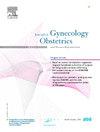胚胎移植当天血清孕酮水平对激素替代治疗周期单次冻融囊胚移植后活产率的影响。
IF 1.6
4区 医学
Q3 OBSTETRICS & GYNECOLOGY
Journal of gynecology obstetrics and human reproduction
Pub Date : 2025-09-05
DOI:10.1016/j.jogoh.2025.103024
引用次数: 0
摘要
目的:随着激素替代疗法冻融胚胎移植周期的增加,确保最大成功率的最佳孕激素水平问题变得至关重要。在这项研究中,我们的目的是用一种原始的统计方法来确定最近报道的3种孕激素阈值的相关性。方法:这项单中心回顾性研究是在法国一家大学医院进行的,研究对象是2021年采用HRT方案进行的所有连续单次冻融囊胚移植(SFBT)。在移植当天早上测量孕酮水平。根据患者在SFBT当天的孕酮水平将患者分为十分位数,并计算每个十分位数的结果。构建多变量logistic回归模型来衡量这些阈值与临床妊娠率和活产率(LBR)的相关性,并对人口统计学和临床因素进行调整。结果:共纳入256个周期。临床妊娠率30.1%,活产率(LBR) 29.3%。观察到LB阳性预测值呈倒U型曲线,在血清孕酮水平高(> - 13ng /ml)时,LB阳性预测值上升至11ng /ml左右的峰值(最佳区间10.5- 12ng /ml),然后下降。结论:我们的研究与最近的文献一致,确定了HRT中SFBT当天黄体酮水平与活产阳性预测值之间的正相关,FET当天黄体酮的“理想窗口”为10.5-12 ng/mL。本文章由计算机程序翻译,如有差异,请以英文原文为准。
Impact of serum progesterone level on the day of embryo transfer on live birth rate after single frozen-thawed blastocyst transfer in hormone replacement therapy cycles
Purpose
As the number of frozen-thawed embryo tryansfer cycles with Hormonal Replacement Therapy increases, the issue of the optimal progesterone level to ensure maximal success rates becomes critical. In this study, we aimed to determine the respective relevance of the 3 recently reported progesterone thresholds using an original statistical method.
Methods
This single-center retrospective study was conducted in a University-based Hospital in France in all consecutive single frozen thawed blastocyst transfers (SFBT) performed with HRT protocol in 2021. Progesterone levels were measured on the morning of the transfer. Patients were divided into deciles based on their progesterone levels on the day of SFBT, and outcomes were calculated for each decile. Multivariate logistic regression models were constructed to measure the association of these thresholds with clinical pregnancy rate and live birth rate (LBR), adjusting for demographic and clinical factors.
Results
A total of 256 cycles were included in the analysis. Clinical pregnancy rate was 30.1%, and live birth rate (LBR) was 29.3%. An inverted U curve was observed for the Positive Predictive Value of a LB, as it increases up to a peak around 11 ng/ml (optimal interval 10.5-12 ng/ml), before decreasing for high serum progesterone levels (>13 ng/ml).
Conclusions
Our study, aligned with recent literature, identified a positive relationship between progesterone levels on the day of SFBT in HRT and the positive predictive value of a live birth, the "ideal window" of progesterone on the day of FET being 10.5-12 ng/mL.
求助全文
通过发布文献求助,成功后即可免费获取论文全文。
去求助
来源期刊

Journal of gynecology obstetrics and human reproduction
Medicine-Obstetrics and Gynecology
CiteScore
3.70
自引率
5.30%
发文量
210
审稿时长
31 days
期刊介绍:
Formerly known as Journal de Gynécologie Obstétrique et Biologie de la Reproduction, Journal of Gynecology Obstetrics and Human Reproduction is the official Academic publication of the French College of Obstetricians and Gynecologists (Collège National des Gynécologues et Obstétriciens Français / CNGOF).
J Gynecol Obstet Hum Reprod publishes monthly, in English, research papers and techniques in the fields of Gynecology, Obstetrics, Neonatology and Human Reproduction: (guest) editorials, original articles, reviews, updates, technical notes, case reports, letters to the editor and guidelines.
Original works include clinical or laboratory investigations and clinical or equipment reports. Reviews include narrative reviews, systematic reviews and meta-analyses.
 求助内容:
求助内容: 应助结果提醒方式:
应助结果提醒方式:


